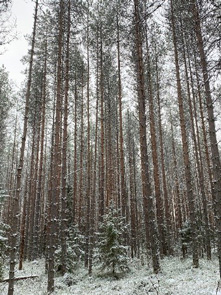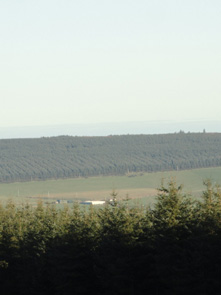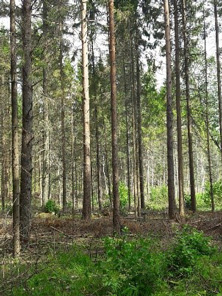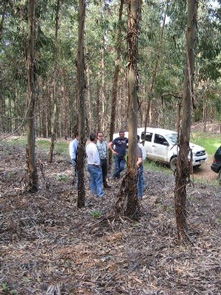Timberland and Natural Capital as Sustainable Investment
Forest and natural capital investment offer many attractive benefits to investors, including portfolio diversification (low volatility and correlation to other major asset classes), attractive risk/return profile, serving as inflation hedge and a solid cash flow potential.
The renewable multi-purpose nature of this asset class, its positive role in carbon sequestration, and availability of internationally and nationally established broad sustainability metrics provide good investment opportunities for those investors that place sustainable development, including the UN Sustainable Development Goals (SDGs) and mitigation of climate change high on their agendas.
Social and environmental sustainability underlies all our investments. We see forest and natural capital investment as an environmentally and socially responsible activity that contributes to sustainable, low-carbon development while generating returns to investors. We are committed to an investment philosophy that integrates rigorous investment analysis with creation of innovative ways to create value from sustainable forest management and delivery of forest-based environmental services, such as carbon, biodiversity and landscape conservation. The investment philosophy is based on the following Natural Capital fundamentals: increasing forest volumes and forest cover; enhancing biodiversity and Nature; removing and stocking of atmospheric carbon in forest stand; and production of sustainable wood to replace fossils-based materials and energy.
Dasos acknowledges the responsibility as investment adviser and manager towards climate change risks and other principal adverse impacts through the investment decisions that we make. The concept of Principal Adverse Impact (PAI) is: “Negative, material or likely to be material effects on sustainability factors that are caused, compounded by or directly linked to investment decisions and advice performed by the legal entity.”
The requirements under the Sustainable Finance Disclosure Regulation Regulatory Technical Standards (SFDR RTS) are detailed and require additional environmental, social, and governance (ESG) data, predominantly on asset-level, that are currently not fully available within Dasos and some of the indicators are not applicable to investments in forest-based real assets. Considering the nature of Dasos investments – forest-based real assets – and availability of relevant sustainability data, Dasos has identified and prioritised the PAIs and indicators relevant to the organisation’s overall investment strategy. If the availability of data improves or there are major changes in the investment strategy, more indicators may be added.
Referring to the Regulation (EU) 2019/2088 of the European Parliament and of the Council on sustainability‐related disclosures in the financial services sector, all except one of Dasos funds promotes, among other characteristics, environmental or social characteristics, or a combination of those characteristics (SFDR Article 8). One Dasos fund has sustainable investment and reduction in carbon emissions as its objective (SFDR Article 9). Dasos investments are sustainability themed, and we integrate sustainability/ESG concerns in all stages of the investment cycle.
Environment
Social and environmental sustainability underlies all our investments. We see forest and natural capital investment as an environmentally and socially responsible activity that contributes to sustainable, low-carbon development while generating returns to investors. We are committed to an investment philosophy that integrates rigorous investment analysis with creation of innovative ways to create value from sustainable forest management and delivery of forest-based environmental services, such as carbon, biodiversity and landscape conservation. We have adopted a comprehensive Forest Investment Policy, which incorporates ESG-related principles as well as forest-specific environmental and social policies and guidelines. Dasos investments contribute to the implementation of the Paris Agreement on climate change to reduce global greenhouse gas emissions and improve transparency of carbon reporting.
Dasos Team has long experience in social and environmental aspects of forest management in various environments in addition to a broad technical know-how crucial in ensuring highly productive forestry combined with enhancement of societal and environmental development objectives.
Certification
We have a policy of investing only in forests that are certified or are certifiable to demonstrate that the forest management in the invested asset is economically viable, socially acceptable and ecologically sound. The independent sustainability certification of forest assets adds value to asset, improves market access, provides verified information on sustainability performance, and mitigates social, environmental and governance related risks. Certification also provides the platform and framework for planning, implementing and monitoring sustainable forest management at a portfolio company (investment) level.
Dasos is committed to have 100% of its forest assets certified as sustainably managed in the context of climate-smart-forestry in compliance with international principles and standards. We are open to all accredited certification systems, including Forest Stewardship Council (FSC®) and Programme for the Endorsement of Forest Certification (PEFC®). The key principles of the internationally endorsed forest certification schemes are integrated into our environmental policy and implementation guidelines.
Sustainability / Environmental, Social and Governance (ESG)
PAIs according to Table 1 of Annex I of the RTS
Indicator 1 GHG (CO2) emissions and indicator 2 Carbon footprint are at the core of the Dasos Funds’ annual climate impact management, monitoring and reporting system. The forest management system, with focus on sustainable wood production, also aims at delivering positive impacts on climate change (carbon stocks and sinks, and indirectly, replacement of fossils-based products and energy). This carbon benefit analysis is consistent with the EU technical screening criteria for contributing substantially to climate change mitigation.
Indicator 3 GHG intensity of investee companies is considered as immaterial as forest assets are considered as carbon storages and carbon sinks with positive climate effects. The same applies to indicator 5 Share of non-renewable energy consumption and production.
Indicator 4 Exposures to companies active in the fossil fuel sector and indicator 6 Energy consumption intensity per high impact climate sector are also considered as immaterial as there are only investments in forest-based real assets through holding companies. The independent regular certification audits cover the following indicators:
- 7. Activities negatively affecting biodiversity-sensitive areas
- 8. Emissions to water
- 10. Violations of UN Global Compact principles and Organisation for Economic Cooperation and Development (OECD) Guidelines for Multinational Enterprises
- 11. Lack of processes and compliance mechanisms to monitor compliance with UN Global Compact principles and OECD Guidelines for Multinational Enterprises
Indicator 9 Hazardous waste ratio will be 0% as no hazardous waste will be generated by investee companies as the only generated waste will be biological waste.
Indicators 12 Unadjusted gender pay gap and 13 Board gender diversity are considered as immaterial, as investee companies are forest holding companies and as such have no employees.
Indicator 14 Exposure to controversial weapons, it is ensured that there is no such exposure as investments are only made in forest holding companies which are not involved in the manufacture or selling of controversial weapons.
Climate and Bioenergy
Climate change and environmental policies are creating the demand to have more land under sustainable forest management. Carbon and other non-timber forest products can provide diversification benefits and an upside to investment returns. Bioenergy related wood revenue has increased in significance over the past years. This trend is driven especially by EU’s renewable energy policies and higher energy prices. The use of wood biomass for energy will provide additional revenue from timberland investments; in some areas competition for wood fibre will drive up wood prices.
Forest Product Demand
Several macrotrends, such as population and GDP growth and bio economy, will drive demand for forest products, and thus for fibre and logs; the global demand for wood is increasing steadily. Based on long-term historical data, real wood prices have increased by about 1.0% annually. Forest product demand and price trends are positive for timberland investment as whole, with considerable regional and country variations. We will aim at utilising investment opportunities derived from regional and country demand-supply imbalances and identify countries that have comparative advantages in supplying wood fibre to deficit areas.
Biological Growth
Biological growth has unique features for investors because trees grow all the time regardless of economic events or market fluctuations resulting in a predictable and positive yield and providing a natural inflation hedge. Dasos focuses on what it sees as the primary driver of revenue generation, i.e. growing and harvesting trees sustainably and profitably with the objective of maximizing benefits from biological growth. Value is enhanced mainly by improving forest management, reducing inefficiencies in harvesting and marketing as well as improving the strategic positioning of the asset, e.g. through expansion or certification. Additional revenue is created through various value creation activities, including payment for ecosystem services.
Higher and Better Use (HBU)
In addition to value creation via intensive, sustainable forest management, we identify opportunities for HBU (Higher and Better Use) through sale or rent of selected forest lots, e.g. for recreation or wind power production, especially when it can simultaneously contribute to rationalising the forest resource base.
Case study Finland

Dasos invested in forestland growing native species in Central-Finland in 2010 and 2012. The forests are located in a very concentrated area with excellent infrastructure and growth conditions.
A long-term wood sales agreement has been established, ensuring demand for all wood assortments and price premiums for certified wood.
Several value creation activities have been carried out on the properties including the utilization of specific HBU opportunities, optimization of harvest and forest management regimes as well as double-certification by both FSC® and PEFC®.
The forests have currently reached a good growing phase, generating increasing cash yield and capital appreciation.
Case study Ireland

Dasos has invested in Ireland since 2015. Sitka spruce in Ireland is the fastest growing softwood asset in Europe achieving mean annual increment of 25 m3/ha/year or more in best sites. This species offers significant value creation opportunities when thinning regimes and final harvest age is optimised. Final harvest takes place at the age of 30-40 years.
With well-designed forest policies for afforestation and climate change mitigation, Ireland also benefits of its excellent location next to the large wood consuming markets such as the UK. HBU potential of the lands can be monetised e.g. for wind farms. In addition, part of the assets is planted with broadleaf trees for biodiversity enhancement purposes and/or managed with continuous cover approach (CCF). PEFC® certification is in progress with more than half of the properties being certified so far.
Case study Estonia

Dasos has launched a buy & build investment programme in Estonia, buying selected forest properties and small property packages from 2010 onwards. Since 2010 Dasos has carried out almost 250 separate transactions. The consolidated forest property integrates substantial values in terms of industrial and conservational rationale.
All forests have been double-certified within PEFC® and FSC®.
Wood sales agreements have been established ensuring demand for all wood assortments and price premium for certified wood.
Further active value creation has been executed by developing optimal harvest and forest management regimes, consolidation of the properties into ever larger entities, developing agriculture land leasing and utilization of HBU opportunities.
Case study Portugal

Dasos has invested in Portugal since 2013. Fast-growing Eucalyptus globulus plantations managed by Dasos in Southern Portugal are FSC® certified. The assets are in the proximity of local pulp and bioenergy industry and wood is being sold with a long-term off-take agreement. The asset is managed on sustainable basis with 10-year rotation cycle.
After the harvest a new tree crop is obtained via stump coppice. After three rotations (30 years) the land is reforested with the best available genetic material. The asset includes significant areas that are set aside for biodiversity conservation purposes.
